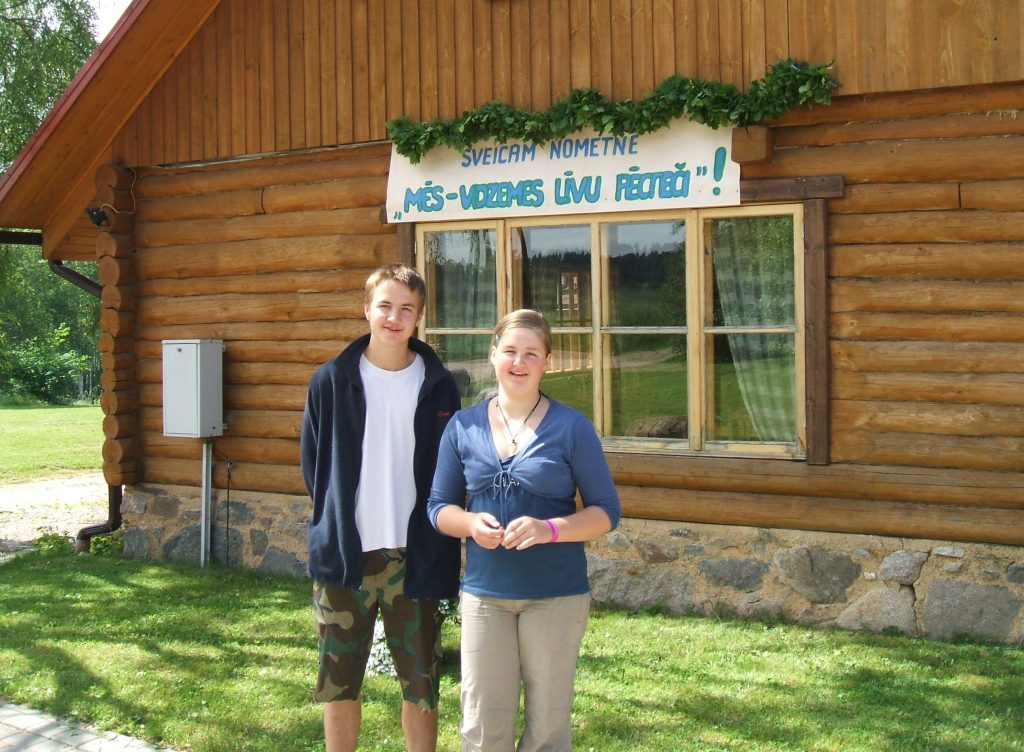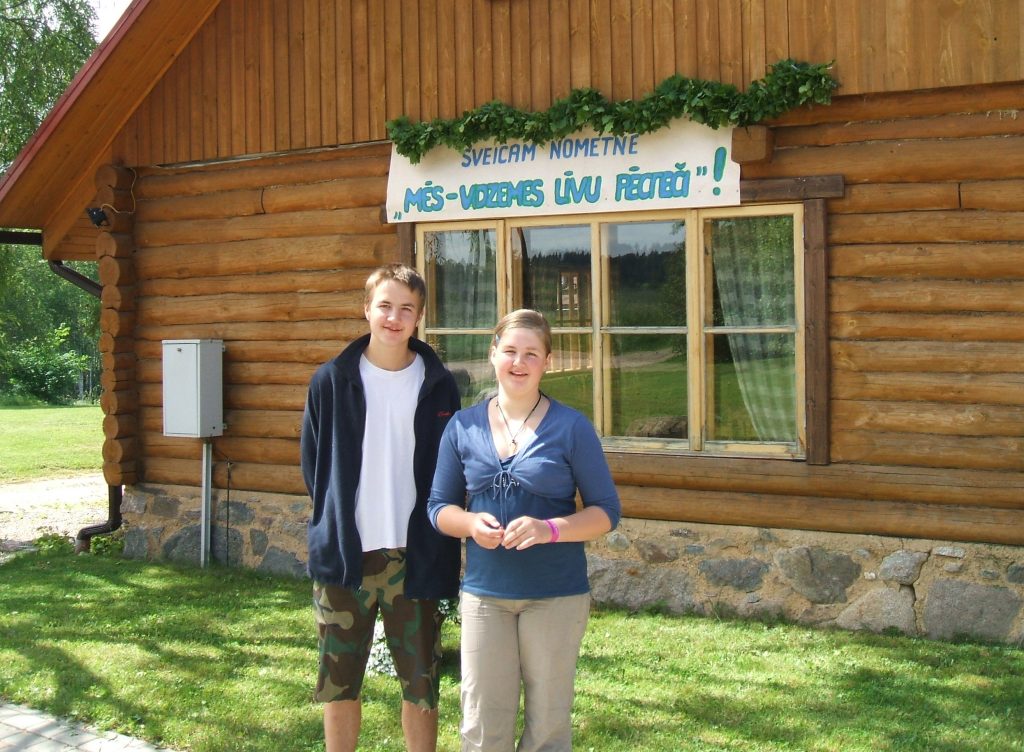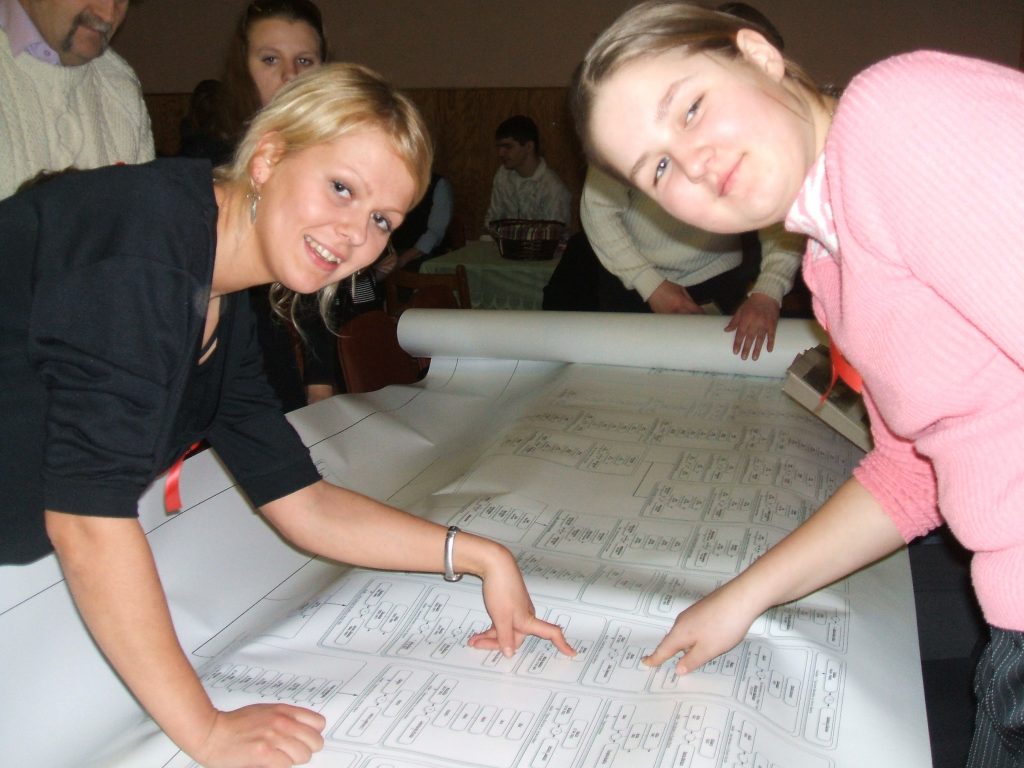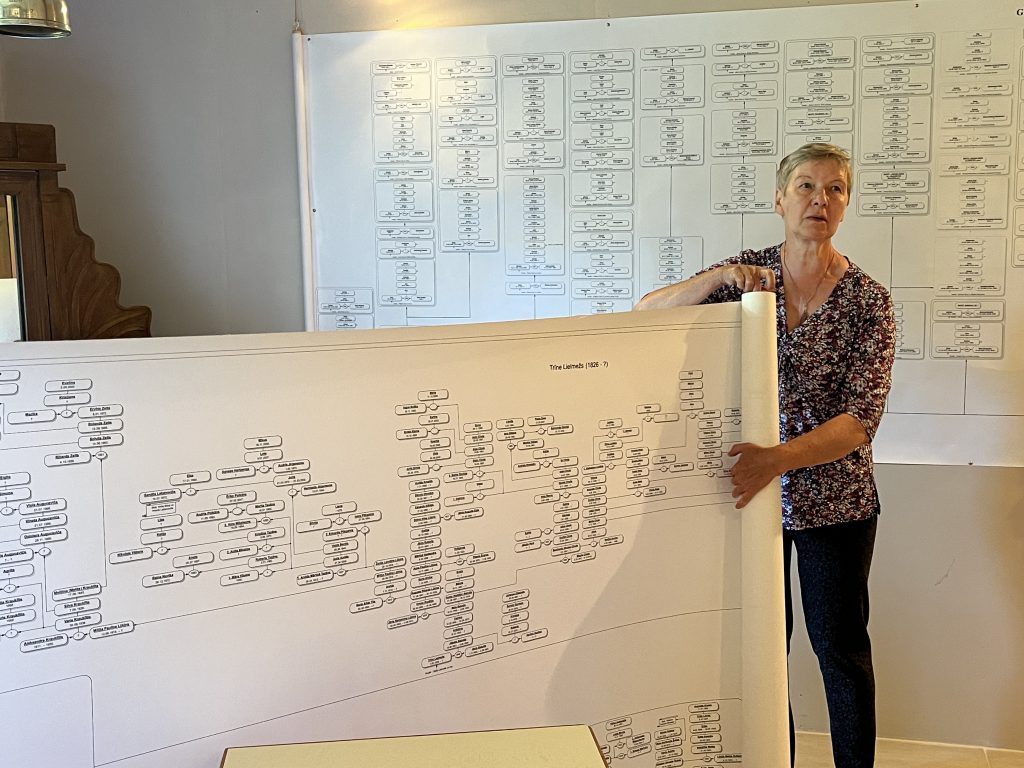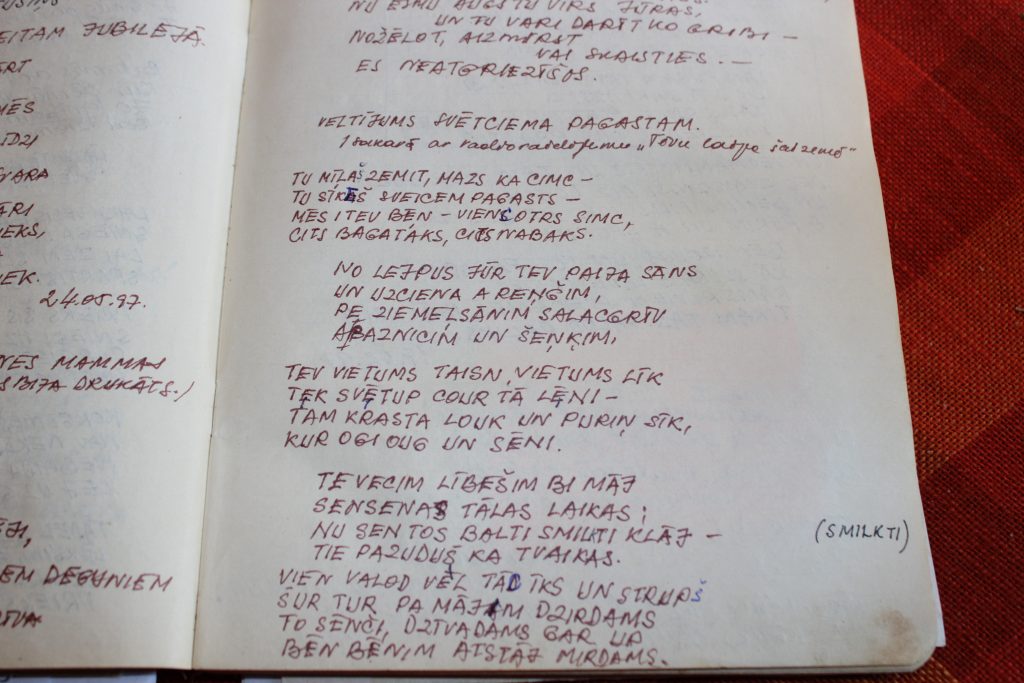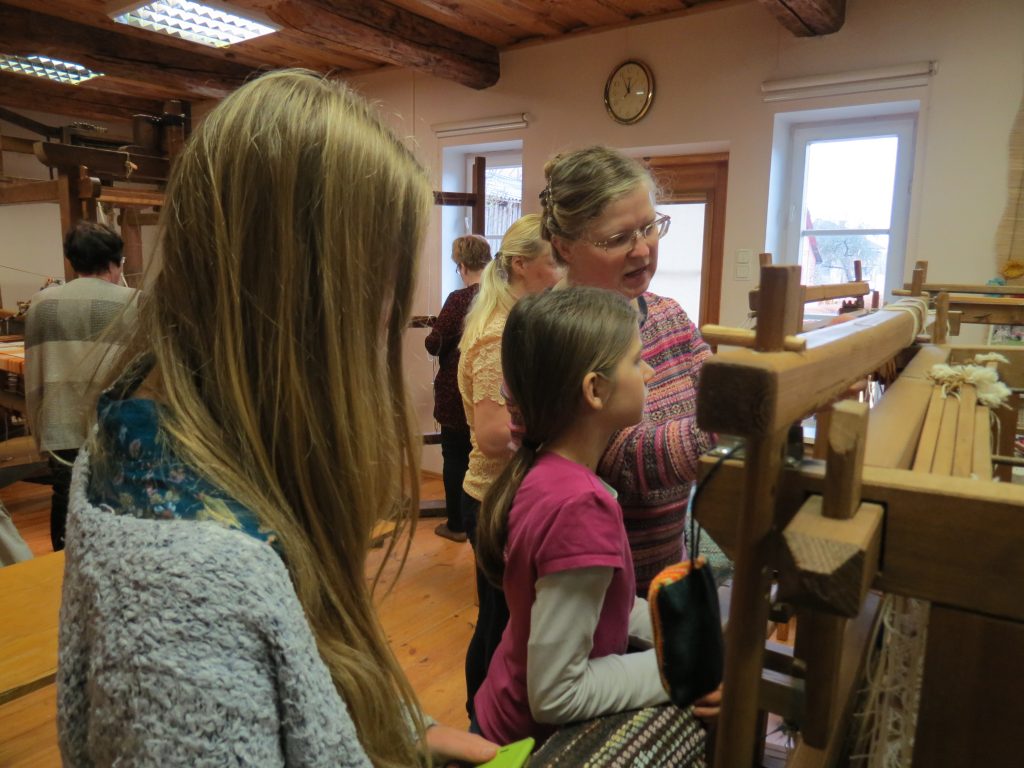Author:
Laima Kļavina, Lolita Ozolina
Oral traditions and their expressions, including language as a vehicle of intangible cultural heritage
Social practices, rituals and festive events
Music/performing arts
Traditional kitchen
Traditional craft skills
Knowledge and practices concerning nature and the universe
Title
Vidzeme Livonian Cultural Space (2022)
Distribution:
Limbaži Municipality; Lēdurga Parish, Sigulda Municipality
Vidzemians who are aware of their Livonian roots today live mostly along the banks of the Svētupe and Salaca rivers – in places like Pāle, Svētciems, Salacgrīva, and Staicele. The sense of identity among the Vidzeme Livonians has been significantly shaped by the genealogical research of historian and local researcher Rasma Noriņa, who has studied the Vidzeme Livonian families. Her research is based on documentation from 1848 by Finnish linguist Anders Johan Sjögren, who recorded information about 22 people in Svētciems Manor and the surrounding areas who could speak the Livonian language (Noriņa 2018). The descendants of these families form the core of the Vidzeme Livonian cultural heritage community. Additionally, the Livonian cultural space of northwest Vidzeme includes people currently living in the former Metsepole region, where elements of the Livonian dialect remain common in everyday speech.
Today, the Vidzeme Livonian cultural space community consists of:
1) Descendants of Vidzeme Livonians: These include members of families such as Āboltiņi–Āboli, Ādmīdiņi, Bērziņi, Bisnieki–Priediņi–Martinsoni, Feldmaņi, Girgensoni–Jirgensoni, Gīzi, Jēkabsoni, Kalēji, Kariņi, Lēniņi, Lielmeži, Lielnori, Pļaviņi, Zīlemaņi, and Zvejnieki;
2) Individuals interested in Livonian culture, history, and dialects: This group includes craftspeople, educators, cultural workers, local historians, and those connected with tourism. Members of the community who have been born and raised in an environment shaped by Livonian cultural features (language, traditions, etc.), and feel a strong connection to these values, also belong to this group. They share a common interest in preserving their identity, feel an attachment to their native region, its cultural values, and the environment. They feel a responsibility for their shared living space, an interest in Finno-Ugric peoples, and a desire to research, preserve, and promote their cultural heritage, especially emphasising the importance of the Salaca Livonian language (Vidzeme Livonian).
Approximately 100 people contribute to the development of the cultural area, including craftspeople, folklore group members, cultural environment caretakers, knowledge-bearers, historians, teachers, and staff and leaders of cultural institutions. These individuals come from various locations in northwest Vidzeme – Ainaži, Salacgrīva, Pāle, Korģene, Vitrupe, Liepupe, Limbaži, Staicele, Aloja, Lēdurga, and others. Some of them appear in the signature sheets in Section B and are also mentioned as masters in Section A.8.
Key members of the community include:
• Zanda Aderniece – expert in holiday traditions, head of the Aloja town and parish administration;
• Alfrēds Andruss – promoter of wedding traditions;
• Jānis Bakmanis – Deputy Chairman of the Municipal Council of Limbaži;
• Einārs Bērziņš – Chairperson of Staicele’s photography society “Laiks”;
• Līga Borozdina – experienced in organising events for all ages, local historian, expert in seasonal and family traditions, head of Svētciems Library;
• Rihards Būda – head of the Staicele city and parish service centre;
• Antra Dūcīte – expert in fishing and maritime traditions, curator of the Ainaži Maritime School Museum;
• Pārsla Dzērve – director of Salacgrīva Cultural Centre, with extensive experience in cultural management;
• Līvija Gridjuško – project manager and local historian;
• Aldis Gusārovs – entrepreneur and developer of the Svētupe Manor complex;
• Indra Jaunzeme – museum director with knowledge of seasonal traditions, director of the Staicele Livonian Museum “Pivālind”;
• Inese Jerāne – cultural event organiser, Salacgrīva Cultural Centre;
• Iveta Kalniņa – curator of Salacgrīva Museum, experienced in museum collection management and textile restoration;
• Sarmīte Kauliņa – expert in wedding traditions, director of Lēdurga Dendropark;
• Guna Krūmiņa – local heritage expert, youthwork organiser, and historian;
• Sanita Kānīte – event organiser for various age groups, head of Ainaži Library;
• Laima Kļaviņa – artist and teacher with knowledge of Salaca parish traditions;
• Jānis Atis Krūmiņš – maker of traditional musical instruments, musician, and skills teacher;
• Inita Ķirse – head of the Melngaiļa Sēta Cultural Education Centre;
• Ilze Millere – experienced project manager and collaborator with foreign partners;
• Līga Moderniece – director of the Aloja Local History Centre, with experience in education and institutional management;
• Rasma Noriņa – historian specialising in the history of Vidzeme Livonian families;
• Liene Noriņa-Šeikina – local history expert, head of the Pāle Parish Local History Museum;
• Inga Ozoliņa – organiser of educational events, librarian at Ainaži Library;
• Lolita Ozoliņa – doctoral student at the Latvian Academy of Culture, scientific assistant at the LAC Institute of Culture and Arts;
• Gundars Plešs – historian and historical building expert;
• Mārīte Purmale – event organiser, consultant to historians on Viļķene’s cultural history, placenames and families, Viļķene library director;
• Ilze Rubene – expert in oral and music traditions, head of the music group “Cielava”;
• Anita Strokša – expert in local traditions, local historian;
• Inese Timermane – family tradition expert, local historian;
• Marta Treimane – inheritor of family traditions, with legal knowledge;
• Ieva Zilvere – director of the Salacgrīva Museum.
Some community members are involved in organisations listed in Section A.9. The community has established its own council with representatives and developed regulations for the Vidzeme Livonian Cultural Space Council – see the Appendix for details.
Significance in community life
The Vidzeme Livonian Culture Space consists of several elements centred around the Vidzeme Livonian dialect in the Latvian language. Vidzeme’s Livonian culture, rooted in the historic Livonian region of Metsepole, continues to live on through the descendants of the Vidzeme Livonians. Besides the dialect, which unifies the broader Livonian cultural space, this heritage is characterised by expressions of intangible cultural heritage, such as seasonal celebrations, a traditional farming lifestyle closely connected to nature, and linguistic heritage, as well as various work-related and lifestyle customs. Additionally, Vidzeme Livonian culture has evolved and found new forms of expression in music, poetry, visual arts, and especially applied arts.
Key values of the Vidzeme Livonian culture (as identified by the community):
• Everyday Use of the Livonian Dialect in Vidzeme: This includes placenames in northwest Vidzeme that have been preserved in the landscape. The distinct nature of this “economic” language has developed over centuries, maintaining traces of historical ties between Finno-Ugric and Baltic peoples. The current use of the Vidzeme Livonian dialect in daily interactions highlights the importance of identity both within and outside the community, preserving oral traditions and expressions;
• Genealogical Research on Vidzeme Livonian Families: The community has embraced the genealogical research of historian Rasma Noriņa, which began in 2003, enhancing the community’s sense of heritage and identity. In 1848, Finnish linguist Anders Johan Sjögren documented the testimonies of 22 people in Svētciems Manor and nearby areas who spoke Livonian. Noriņa’s genealogical work has led to the creation of 16 family trees, fostering pride and awareness of Livonian roots among locals. This research has also made the Pāle Local History Museum a central meeting point for Vidzeme Livonian descendants. Annual gatherings of Livonian descendants began in 2003 in Pāle, and now take place two to four times a year, drawing together families from Latvia and beyond;
• Preservation of the Vidzeme Livonian Cultural Space, folklore, inherited crafts and traditional knowledge;
• Writing and Publishing Literature in the Salaca Livonian Language and Vidzeme Dialect: Examples include the first book in the Salaca Livonian language, “Salats joug kolm aģa” (“Three Banks of the Salaca River”), published by the Livonian Friends Society in 2013. In 2014, Anita Emperēja’s poetry collection “Saknes” featured poems in the Svētciems dialect. Finnish poet Heli Laaksonen’s work was also translated using the Vidzeme dialect, promoting its use in contemporary literature;
• Honouring and preserving sites related to Livonian heritage, such as the Livonian Sacrificial Cave – a sacred site on the banks of the Svētupe River – the Liepupe hillfort, ancient burial grounds, and others.
Activities
In the Vidzeme Livonian cultural space, the Vidzeme dialects of the Livonian language are still spoken and can be heard in Ainaži, Korģene, Kuiviži, Lauvas, Pāle, Lēdurga, Limbaži, Salacgrīva, Svētciems, Vitrupe, and along the Estonian border towards Rūjiena. Folklore, oral traditions, and ancient craftsmanship, which remain alive today in coastal Vidzeme, Korģene, Lauvas, Lēdurga, Pāle, Svētciems, and other places, provide insight into the lifestyle of the inhabitants of northwest Vidzeme, including the descendants of the Vidzeme Livonians both past and present. For example, words like kunna (frog), roida (dirt, debris), sonnis (ram), randmala (shoreline), kamma (large flounder), and expressions such as “muldeņi rādās” (nightmares appear), “ak, tu vec kuž!” (oh, you old mare!), “dabūs pa ķobi/poģi!” (you’ll get hit on the head!), and “pārsist govi!” (to tie up the cow!), are still used in everyday language within the Vidzeme Livonian cultural area. According to Anita Emse, a specialist in the Svētciems dialect, the area was once called Sveiciems. “People in Sveiciems say everything with an -i ending—roki (hand), kāji (leg), mājiņi (small house), puķīši (flowers), asariņi (little tears), brēteliņi (small fish). The Sveiciems locals say, ‘the ducks have red beaks, or the girls are round like vimba fish!’ In Vitrupe, they speak in a Vitrupian style, though slightly differently from Sveiciems. In Salacgrīva, they drop word endings, and in Ainaži, there is a strong Estonian influence.” (Anita Emse’s account from May 2022, preserved at the University of Latvia’s Livonian Institute).
Historian Rasma Noriņa has focused on researching the history of Vidzeme Livonian families. For over 20 years she has continued this work, creating family trees for 16 Vidzeme Livonian families and identifying at least 615 descendants of the Vidzeme Livonians. Noriņa’s research is preserved and promoted by Liene Noriņa-Šeikina, who manages the Pāle Local History Museum – the only museum in Latvia dedicated to the Vidzeme Livonians, where information on Vidzeme Livonian history and families (such as Ādmīdiņš, Bērziņš, Bisnieks, Feldmanis, Lielnors, and others) is available. In Staicele, there is also the Livonian Museum “Pivālind,” led by Indra Jaunzeme, which conducts research on the history of Staicele and its surroundings, with a focus on placenames and evidence of Livonian cultural heritage in the local environment.
New works continue to be created in the Salaca Livonian language. Musician Elīna Ose, along with like-minded colleagues, has prepared a chamber music concert programme titled “Kuolm randõ/Three Shores”, which includes songs in the Salaca Livonian language. Meanwhile, the latest poem by Ķempju Kārlis (real name Karl Pajusalu) is called “Tuļpuķķiž” (“In the Fireweed”) and was written in 2021:
syu vīmi tuļ
mer peru pilu
utab ta ķädde
kītebed ku jenim
sie kruon ruja
ab lask tunda
ǖdegid karde
nei ma irmig
nūškub jega puķķi
nūškub jega āņe
abku sin jenge
tuļpuķid tuļ
lämtub touvizt
ǖd tēd reiz
In northwest Vidzeme, various cultural and tourism-related activities take place in many locations, offering insights into the Livonian heritage and its characteristics, thus highlighting the uniqueness of each area, parish, district, and town.
Inheritance and transmission
The transmission of language dialects within the Vidzeme Livonian cultural space mainly occurs within families, while craftsmanship skills are preserved in interest groups, folk applied arts studios, and workshops, such as the Weaver’s House in Staicele and the annual event “Meet Your Craftsman!” Oral traditions and the heritage of traditional music are passed on through folklore groups and musicians’ ensembles (“Putni,” “Cielava,” “Cielavas Spēlmaņi”), as well as in summer camps, events at the Lēdurga Dendropark, and at Melngailis’ Homestead in Vidriži.
The cultural heritage of the Vidzeme Livonians is researched and promoted through exhibitions, displays, and various events at the Pāle Local History Museum, the Salacgrīva Museum, and the Livonian Museum “Pivālind” in Staicele.
The maintenance of ritual traditions informally takes place at the Livonian Upuralas in Kuiķule, where a cult site (a state-protected archaeological monument) is located on the banks of the Svētupe River. Centuries-old rock carvings, possibly magical protective symbols, have been discovered in the caves, along with offerings. It is noteworthy that even today, people visit this ancient sanctuary and leave offerings. In recent years, various rituals and seasonal celebration events have also taken place near the Mudurgas Great Stone in Lēdurga, which has long been a gathering place for local people.
History
The Vidzeme Livonians as an ethnic group formed in the 10th and 11th centuries, inhabiting the banks of the Gauja and Daugava Rivers. More extensive information about the Livonians living in Vidzeme at the end of the 12th century and the beginning of the 13th century is provided by the Chronicle of Henry of Livonia (Henry’s Chronicle 1993). The Vidzeme Livonians were the first among the nationalities of Latvia to come into contact with German merchants and Catholic missionaries in the 1180s; they were the first to be subjected to the Crusaders and the first to experience the process of assimilation into the Latvian population (Vasks et al. 2021). Over the centuries, the number of Livonians in Vidzeme steadily decreased. The assimilation of the Vidzeme Livonians, likely the descendants of the Metsepole Livonians (in Livonian: Mõtsa pūol), into the Latvian ethnic group was completed by the mid-19th century (Cimermanis 2003: 11–27). Gusts Bisnieks, who died in 1868, is considered the last speaker of the Vidzeme Livonian language. In the mid-19th century, the Livonian language was still spoken in northwestern Vidzeme, as evidenced by documented reports from the Finnish linguist Anders Johan Sjögren in 1848, who records about 22 Livonian-speaking individuals in Svētciems Manor and the surrounding areas (Noriņa 2018).
Over the centuries, the area the Livonians historically inhabited in Vidzeme has undergone significant changes. However, the Vidzeme Livonian cultural space still retains the Baltic Sea Finnic substrate, which is primarily manifested in the language – specifically, in the Livonian dialects of Vidzeme – and in placenames, as well as in the evidence of cultural and historical heritage found in the landscape, such as hill forts, sacred sites, and ancient burial grounds.
For a more detailed description of the history of this aspect, see Appendix.
The Vidzeme Livonian cultural space still holds undiscovered and unrecognised evidence of the development of culture and the lifestyles of local people. The Livonian heritage in Vidzeme has been relatively under-researched, with the most significant studies related to Vidzeme Livonians conducted by Anders Johan Sjögren, Saulvedis Cimermanis, Rasma Noriņa, and linguists Karl Pajusalu and Eberhard Winkler, who have studied the Salaca Livonian language.
Although the community speaking the Salaca Livonian language disbanded in the late 19th and early 20th centuries, there has been a growing awareness of Livonian identity in northwest Vidzeme over the past 20 years. This process is largely based on the research conducted by historian Rasma Noriņa on the Vidzeme Livonian families, which encourages their descendants to recognise their roots, come together, and meet one another. It is known that at least one descendant of the Vidzeme Livonians has “Livonian” listed as their nationality in their passport. Several well-known public figures, cultural workers, journalists, musicians, and artists in Latvia come from Vidzeme Livonian families. Increasing interest in Livonian heritage is also being shown by other residents of northwest Vidzeme who are not of Livonian descent.
Additional Information
The Vidzeme Livonian cultural space is characterised by other expressions of intangible cultural heritage as well. For example, the traditional methods of farming that have been preserved in the homesteads and small farms of northwest Vidzeme (organic farms) involve livestock breeding, crop farming, handicrafts, and beekeeping. In such farming practices, almost the entire family is typically involved. Fishing traditions, such as lampreyfishing in the Salaca River and the Svētupe River, have also been maintained. In Salacgrīva, fishermen still use a centuries-old fishing technique called “murdu tacis” for catching lamprey. Although the fishing industry has declined, coastal fishermen still go to sea, and their professional vocabulary includes names for fishing tools, fish, and other terms borrowed from Livonian and Estonian (as well as from German and Russian). In order to improve soil quality, residents in coastal villages and towns still collect washed-up seaweed along the shore.
Similarly, knowledge about medicinal plants, their harvesting times, and methods for preparing and using tea has been preserved and is applied in daily life. Several weavers in Limbaži, Staicele, Viļķene, and other areas have knowledge of natural plant dyes. Knowledge of determining weather conditions based on natural phenomena, as well as favourable times for fishing, sowing, and planting, has also been retained.
The skills of preparing traditional dishes are applied along the Vidzeme seaside and further inland. The skill of baking bread is maintained by several housewives in Lēdurga. Skilled carpenters still work in Limbaži, Liepupe, Salacgrīva, Staicele, and elsewhere, making ancient musical instruments, beehives, log cabins, and more. For example, the folklore group “Putni” from the Lēdurga Cultural Centre has mastered the skills of making and playing musical instruments. Participants in folklore groups can also make traditional masks; for instance, the folklore group “Cielava” has experience in organising the international Mask Tradition Festival.
Among household traditions, certain customs and rituals related to baptisms, weddings, and funerals have been preserved. Newlyweds and wedding guests can experience the old wedding traditions at the Melngaiļa farm in Vidriži (managed by Inita Ķirse) with Alfreds Andrus, and at the Dendropark in Lēdurga (managed by Sarmīte Kauliņa). Once popular communal work gatherings (talkas) are now rarely organised, but they still take place in the autumn during the harvest season.
Seasonal festivals have maintained their significance and are celebrated both in families and in the cultural centres of towns and villages. During Easter, Jāņi (Midsummer), Miķeļi, Mārtiņi, and Christmas, events are enriched by performances from folklore groups. The celebration of seasonal festivals takes place both outdoors and in cultural centre facilities. Easter, Jāņi, and Christmas are also celebrated within families, among relatives and neighbours, but they no longer resonate as widely as they did in the 1920s and 1930s. Children first learn about seasonal festivals in the family, at school, and in folklore clubs.
Masters
In the community of the Vidzeme Livonian cultural space, there are several active local tradition-bearers and experts:
• Iveta Apsīte – weaver, promoter of weaving and dyeing skills using plant dyes, TLMS “Staicele”;
• Ance Bumble – inheritor and promoter of bread-baking traditions;
• Anita Emse – expert and promoter of the Svētciems dialect;
• Irēna Graviņa – weaver, inheritor and promoter of weaving traditions, TLMS “Staicele”;
• Edīte Kalniņa – weaver, inheritor and promoter of weaving traditions, TLMS “Staicele”;
• Kristīne Kapakle – inheritor and promoter of fish smoking techniques;
• Ilze Kļaviņa – expert in traditional kokle playing, maker of traditional masks;
• Ilga Līsmane – weaver, inheritor and promoter of weaving skills, TLMS “Staicele”;
• Elga Melne – expert in the Aloja dialect, knowledge-bearer of regional words, including Livonian;
• Anda Timermane – inheritor and promoter of weaving traditions, TLMS “Staicele”;
• Inese Timermane – weaver, inheritor and promoter of weaving traditions, director of TLMS “Staicele”;
• Pārsla Treimane – craftswoman, expert and promoter of embroidery techniques.
Institutions and organizations
• Associations: “Smailes,” the “Vidzeme Livonian Centre” division of the association “Make Art,” “Limbažu Lauvas,” the “Metsepole Livonian Cultural Centre”, “Pivālind,” the Staicele photography association “Laiks,” and the Vidzeme Livonian Regions Cultural Association “Elmed” (after statute changes, now called “Elmed Cultural Association”);
• Libraries: Ainaži, Korģene, Svētciems branch libraries of Salacgrīva Library, Viļķene branch library of Limbaži Central Library;
• Culture houses and centres: Lēdurga culture house, the Centre for the Culture of Salacgrīva, the cultural education centre “Melngaiļa sēta”, handicraft studio “Aģe” and TLMS “Staicele”;
• Folklore groups: folklore group “Putni” from the Lēdurga Cultural Centre, “Lieli Putni”, “Malībieši”, “Cielava”, musician group “Cielavas spēlmaņi”;
• Museums: Ainaži Maritime School Museum, Pāle Local History Museum, Salacgrīva Museum, Staicele Livonian Museum “Pivālind,” Aloja Local History Centre;
• Institutions: Limbaži Municipality, Limbaži Municipality Aloja Union Administration, Sigulda Municipality Sigulda Development Agency Division “Lēdurga Dendropark,” Staicele City and Parish Service Centre;
• Commercial companies: SIA “Svētupes muiža”, “Lolitas Ozoliņas komunikāciju konsultācijas”.
Reinforcement:
Over the past 30 years, several activities and projects in northwest Vidzeme have supported the development, preservation, and promotion of the Vidzeme Livonian cultural area. Key events are listed chronologically:
• In 1988/89, Zenta Mennika, leader of the folklore group “Cielava,” began documenting song texts from northwest Vidzeme, including Livonian dialects, melodies, and games;
• In 1997, ethnographic research began in the Salaca parish in collaboration with the Latvian Folklore Repository, leading to the first “Metsepole” camp, which has since introduced 260 children to their native land;
• In 1998, the conference-exhibition “Folk Costume and Dowry” took place. The Salaca branch of VAK was established, followed by the foundation of the association “Elmed.” The “Northern Vidzeme” project was also implemented;
• In 1999, in partnership with Staicele Municipality, the Livonian Culture Centre (Līvõ kultūr sidām), the state’s specially protected Livonian historical area, the “Livonian Coast,” and the Latvian Academy of Sciences, the event “Livonians Return to Latvia” was organised. This inspired more research into Vidzeme’s Livonian heritage and the Salaca Livonian language, as well as the establishment of the Staicele Livonian Museum “Pivālind”;
• In 1999, the first Bread Festival was held in Lēdurga, with participants from the “Metsepole” camp;
• From 2001 to 2003, local researchers from Limbaži district joined expeditions and conferences on Vidzeme Livonian issues organised by the Latvian Academy of Sciences;
• In 2002, research on descendants of Vidzeme Livonians began at the Pāle Local History Museum;
• In 2003, the first gathering of Vidzeme Livonian descendants took place in Pāle;
• In 2006, the first “Pivālind Festival” was held in Staicele, and the folklore group “Cielavas spēlmaņi” was founded;
• In 2009, the exhibition “Vidzeme Livonians and Their Descendants” opened at the Pāle Local History Museum;
• In 2011, a ceremony in Salacgrīva celebrated the publication of Estonian poet Kempi Karl’s (real name Karl Pajusalu) collection “Salats joug kolm aģa” (“The Three Banks of the Salaca River”);
• In 2014, Anita Emse published her poetry collection “Saknes,” which includes several poems in the Svētciems dialect;
• In 2018, Rasma Noriņa’s book “Vidzeme Livonian Families” was published;
• In 2019, the folklore groups “Cielava” and “Delve” participated in the Turaida Museum Reserve Folklore Festival;
• In 2020, the folklore group “Putni” participated in a virtual folklore festival organised by Estonians in Tartu.
Several activities have also been implemented in the centres of Vidzeme Livonian culture:
• In Staicele, auto-photo-bicycle orienteering events with a large number of participants have been organised by Staicele TIC (led by Inese Timermane) and the youth association “Pivālind” (led by Anda Timermane). Similar events in Limbaži district and Vidzeme aim to help young people, families with children, and other enthusiasts get to know the region better and learn about its cultural history. In collaboration with the Staicele library and the photo association “Laiks,” the exhibition “The Power of Natural Colours in Threads” was held. Several travelling exhibitions took place at Mazsalaca’s Craft House, Stāmeriena’s Community Centre, Mēru Manor in Smiltene, and elsewhere. Craftspeople also participated in Vidzeme’s Entrepreneur Days in Valmiera and in craft markets. Through collaboration with the youth association “Pivālind,” the project “My Diligent Sister” was implemented;
• At the Pāle Local History Museum, research on the history of Vidzeme Livonian families continues (undertaken by Rasma Noriņa), alongside educational and community events for Vidzeme Livonian families under museum director Liene Noriņa-Šeikina’s leadership. In several areas, the younger generation and NGOs (such as the association “Smailes”), along with local historians in Aloja, Staicele, Svētciems, Vidriži, Lēdurga, and elsewhere in Vidzeme, have been documenting and recording stories of local residents;
• In Lēdurga, traditional crafts and artisans of Krimulda municipality have been identified. The folklore group “Putni” has been involved in educational events, learning new songs, and preparing for folklore festivals. In 2022, Ilze Kļaviņa appeared on the TV show “Pa straumei”, discussing Livonian heritage in Lēdurga and promoting the Lēdurga Dendropark;
• In Salacgrīva, the folklore group “Cielava” and the music ensemble “Cielavas spēlmaņi” expanded their repertoire and took part in several festivals and district celebrations. In 2022, the folklore materials collected by Zenta Mennika were taken over, and her work is now being continued by Laura Eimane from the folklore group “Cielava” and Ilze Rubene from “Cielavas spēlmaņi”.
1. Public interest has grown regarding Vidzeme’s Livonians, their cultural heritage, and the Vidzeme dialects of the Livonian language; 2. Scientific publications and books have been published; 3. Collaboration has developed among associations, institutions, and individuals; 4. The younger generation has gained knowledge about Vidzeme’s Livonians and an understanding of gathering the folklore material; 5. Cooperation with other Finno-Ugric peoples has begun.
Several projects have been implemented with funding from local government and various other funds (e.g. the Latvian Culture Fund, the State Culture Capital Fund (VKKF), and the Latvian Environmental Protection Fund (LVAF)). Some initiatives have been carried out with private funds, as well as volunteer labour and intellectual contributions.
The most significant projects implemented so far and the aid received:
• “Smailes” – “Playing the Traditional Kokle – a Fun Way to Spend Free Time.” Planned completion in 2022. Supported in two phases. Funding from the Rural Support Service;
• Salacgrīva Museum – “Livonian Belonging.” Implementation period 2021–2024. Funding for phase 1 from the Salacgrīva municipality budget, phase 2 from the State Culture Capital Foundation (VKKF);
• Creative stipend for Rasma Noriņa – “Photo Album about the Bisnieki–Priediņi Family of Vidzeme’s Livonians.” 2020–2021. Funding from VKKF;
• Staicele Livonian Museum “Pivālind” – “Storytelling about Staicele.” 2020. Funding from VKKF;
• Staicele Livonian Museum “Pivālind” – “Under the Thick Branches of the Oak Tree… Places and Traditions for Celebrating Greenery Days in the Staicele Region” 2019. Funding from VKKF;
• Staicele Livonian Museum “Pivālind” – “This Wonderful Path to My Father’s Home”, in two phases. 2014–2015. Funding from VKKF;
• Traditional Folklore group “Putni” – “Mastering Ancient Craft Skills – Interesting and Contemporary.” 2012–2013. Funding from VKKF;
• Traditional Folklore Group “Putni” – “Laimas Maize.” The tradition of bread-baking in Lēdurga Parish. 2008. Funding from the Limbaži District Council;
• Pāle Parish Council and Rasma Noriņa – “Travelling Exhibition ‘Vidzeme’s Livonians and Their Descendants.’” 2008. Funding from VKKF;
• Vidzeme Livonian District Cultural Association “Elmed” – “Sixth Student Summer Camp ‘Metsepole.’” 2006. Self-funded for the first themed part, as well as co-funded from Lēdurga Primary School and the Education, Youth, and Sports Department of Riga City Council; funding from the Latvian Environmental Protection Fund (LVAFA) for the second part;
• Salaca Environmental Protection Club. Project “Fifth Student Summer Camp ‘Metsepole’” in Kolka. 2001. Self-funding, along with co-funding from the Ikšķile Town Council and SIA “Lauku Avīze.”
Continuation/development
Research work will continue in archives, museums, etc., to identify Livonian heritage in Vidzeme.
Rasmas Noriņa’s work on a book on the Vidzeme Livonian family Kariņi will continue.
Local researchers will continue to document the cultural values of the parishes. Materials will be collected about notable local figures (such as E. Putniņš, G. Sedlenieks, and others) in order to prepare publications. The accumulated materials will be available in libraries, museums, private collections, as well as in exhibitions and themed events. A more detailed plan for the preservation of elements, including specific activities, can be found in the Appendix.
Various activities are planned to be implemented for the preservation of the Vidzeme Livonian cultural space and the strengthening of the community, focusing on research, cultural education, and the promotion and transmission of intangible cultural heritage. A more detailed plan for the preservation of cultural elements, including specific activities, can be found in the Appendix.
• Strengthen and expand the Vidzeme Livonian cultural space heritage community;
• Promote the recognition and preservation of the intangible cultural heritage of northwest Vidzeme, including Livonian heritage;
• Strengthen and enhance the understanding of the Vidzeme Livonian cultural area and its unique characteristics and value.
Threats
The existence of the Vidzeme Livonian cultural space can be influenced by a number of factors and circumstances. Here are some of them:
• Demographic – as the younger generations move away from their hometowns to work abroad and/or in Latvia’s larger cities, the number of residents and community members decreases. Additionally, as generations change, the number of speakers of the Livonian dialect in Vidzeme is also declining;
• Consumerism – with the increasing influence of globalisation and technological development, the importance of traditional lifestyles, along with traditional knowledge and skills, diminishes;
• Informational – the residents of northwest Vidzeme lack knowledge and understanding of the Vidzeme Livonian heritage, the linguistic and historical significance of the language dialects, as well as their value in today’s cultural environment. There is a lack of scientific research on the Vidzeme Livonians, their history, and the legacy they have left behind;
• Financial – limited possibilities for organising wide-ranging, community-based events which strengthen identity.
Applicant
“Smailes” Association, Registration No. 40008205262
Image Gallery
Audio Materials
Video materials:
Text Materials
Publications
Noriņa, R. (2018). "Vidzemes lībiešu dzimtas. No 18. gs. līdz mūsu dienām". Riga: Zinātne.
Kursīte, J., Noriņa, R. (2016). Svētupe krustām šķērsām. Rīga: Nordik.
Laime, S., Urtāns, J. (2016). Svētupes lībiešu upurala. Rīga: Nordik.
Putniņš, E. (1985). Svētciema izloksnes apraksts. Rīga: Zinātne.
Ancītis, K., Jansons, A. (1963). Vidzemes etniskās vēstures jautājumi. Arheoloģija un etnogrāfija. Rīga: Latvian SSR Academy of Sciences publishing.
Cimermanis, S. (1998). Par lībiešu saplūšanu ar latviešiem: jautājuma izzināšanas ievirzei. Latvijas Zinātņu Akadēmijas Vēstis. A daļa. Nr. 3.
Websites
S. Cimermanis. All about our Livonians. (2001). - On the first scientific contribution to the national long-term target program "Livonians in Latvia."
On the future of the Livonian people – in their children, culture, and written legacy. - On the Livonian Cultural Days held in 1998, presentations from academic speakers (A. Caune, S. Cimermanis, R. Blumberga, I. Neilande, E. Sīlis, and others) are available.
S. Cimermanis. The Livonian mark. - on published research, cultural historical materials devoted to the Livonian poet, cultural worker and translator Janis Princis Senior in his 200-year anniversary.
Aldura Vunks. Salaca Livonian in during the Enlightenment. (2018). - The article in English examines the state of the Livonian language in the Salaca region in the 18th century, providing information on Livonian families and speakers, as well as the factors that influenced the decline of the Livonian language.
Digital archive of Latvian folklore storage. - folklore materials recorded in Northwest Vidzeme are available.
Laima's bread. (2014). - The video on the bread-baking tradition in Lēdurga parish by Limbaži TV.
So we live – Salacgriva fishermen. (2020). - Vidzeme television programme on the fishing tradition in Salacgriva.
Salacas Livonian dictionary. - Information about the Salaca Livonian language dictionary published in 2009, compiled by Professor Eberhard Winklerun from the University of Göttingen and Professor Karl Pajusalu from the University of Tartu.

